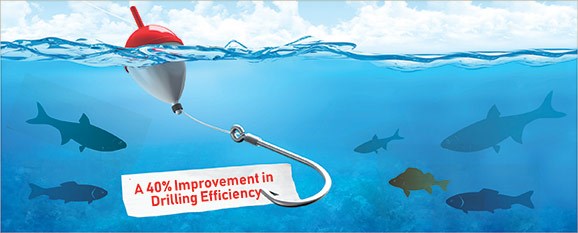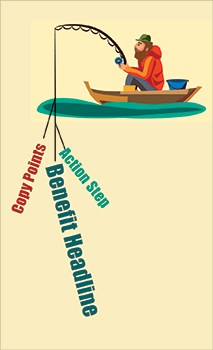The Fisherman Approach to Print Advertising
Hook-less ads are a waste of money. Trade magazines with lots of information-hungry readers represent oceans of possibilities. You just need to know which bait to use. Here are some ideas to stop readers and reel them in.

By Bob Lamons, President
industribrand
When I began my career in advertising some 45 years ago, it was drilled into our heads that print ads should start with a strong headline containing a benefit designed to lure the reader into the ad. We actually spent time considering various benefits before we started writing our headline.
Today, I'm sad to report you can flip through entire trade magazines and not find a single ad containing any headline benefit, much less a strong one. Either today's ad writers think putting benefits in headlines is unnecessary, or they've never even considered it. Probably the latter.
A recent issue of a leading oil industry magazine arrived in my mailbox the other day boasting 26 full-page ads with not a tempting headline lure among them. Some ads featured self-centered heads like "Power is our craft" or "We know elastomers." Is that supposed to make you thirst for more?
Others featured one or 2-word heads like "Confident" or "Controlled Intensity." Do ad creatives really think that's powerful selling stuff?
Trade magazine publishers have been under fire for years because some people claim that nobody reads magazines anymore. Young people get their news off Facebook and You Tube, I'm told. People with this attitude will say that magazine ads are a waste of money, and I will agree with them if you're talking about lazy ads that fail to stop the reader and reel them in.
It's a self-fulfilling prophecy that ineffective, poorly crafted ads are a waste of money, but the problem is not with the publication. Trade publications aggregate viewers with common needs and interests. It's like a small pond stocked with hundreds of hungry catfish. If you throw an empty hook in the water, you shouldn't expect much to happen.
As an experiment, I decided to take a look at one of the 3-word headlined ads in the previously mentioned oil industry magazine. The head was "Need for speed" and the copy was largely devoted to something called "anti stick-slip technology." In the next to last sentence, I discovered this nugget: our models demonstrate an improvement of 40% in drilling efficiency.
Really? A 40% improvement in drilling rates? And why wouldn't that be the point you lead with? You're expecting readers to find it in the next to last sentence of body copy?
That's what we used to call a killer assumption, and it's killing the print magazine industry. Anytime you can flip through an entire magazine without finding an ad designed to stop the reader, one promising a benefit and encouraging the reader to take appropriate action, you can bet those ads are doomed to fail.

Which leads me to another point: not only should ads have headlines that reel you in, they should also make it easy to find the answers you need. We used to call that the action step. In the old days, magazines had reader service numbers at the bottom of each ad and a "bingo" card in the back for you to circle the number of the ad you were interested in. Sounds quaint now, but it worked because it was easy to use.
Today's readers are too impatient to wait several weeks or a month for information to arrive. Smart advertisers now drive prospects to a landing page -- a side door to your website where information tailored to each ad is waiting for the customer seeking instant gratification. (It's a mistake to send prospects to your home page because they may get lost en route to the info they need. Create instead a more direct path.)
One more tip for advertisers fishing for customers: learn the long-lost skill of "copy points." As a beginning copywriter, I was forced to pore over stacks of reference material looking for features AND benefits. We were taught to write simple, declarative sentences containing one feature and one benefit.
For example: the rod is made of specially formulated titanium alloy for a 50% longer life. The feature is the titanium construction and longer life is the benefit. If the titanium construction yielded more than one benefit (e.g., lighter weight) you wrote more than one copy point.
We were instructed to fill as many pages as possible with copy points. Then we arranged them in related groups and attempted to prioritize them from most important to least important. Only then did we start writing copy. Todays writers start writing before they even know all the points they might make on behalf of the product or service.
The next time someone tells you that trade magazines are a waste of money, you should set them straight. Hook-less ads are a waste of money. Trade magazines with lots of information-hungry readers represent oceans of possibilities. You just need to know which bait to use.
Need more information?
Bob Lamons, President
industribrand
43 Winged Foot Drive
Conroe, Texas 77304
713-828-7000
About the Author
Bob Lamons
Bob is a past national chairman of the Business Marketing Association and the author of "The Case For B2B Branding" the first branding book for business-to-business marketers.
RELATED CONTENT
-
Media Solutions to Provide Direct Reach to Markets Served
As Account Manager in Sales serving the industrial audience with the latest informational content regarding the ever changing trends, Maalik Bomar plans to continue forward providing the best customer service to those client professionals seeking a direct reach to their markets served.
-
Trade Publications Deliver Double ROI Punch: Advertising and Technical Know-How
When Dianna Huff first wrote about Gardner’s survey data, she took the tilt toward print with a grain of salt because Gardner is in the business of producing print. Since writing that post, she’s visited a number of small manufacturers where she sees that trade publications are seemingly thriving. To see if her assumptions were correct, she spoke with Rick Kline, Sr. CEO of Gardner Business Media.
-
Veteran Marketers Know How Print Plays in Their Plans. Do You?
There’s more than enough research showing print engenders higher recall and a satisfying social effect with readers.


